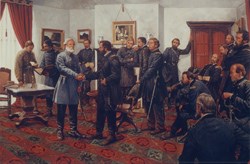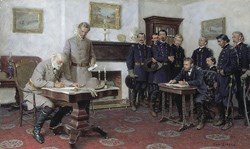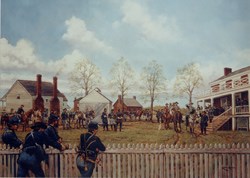
Keith Rocco As the fighting came to an end that morning of April 9, 1865, the village of Appomattox Court House lay between the two armies. General Robert E. Lee sent a final note to General Ulysses S. Grant asking for a meeting to discuss the surrender of the Army of Northern Virginia. Grant received the note and replied that he was on his way and asked that Lee choose a suitable location for the meeting. With nearly 95,000 combatants within a few miles of the village, most residents had fled the area. The McLean family remained however, and Wilmer McLean began looking around the village out of curiosity. He was approached by Lieutenant Colonel Charles Marshall of Lee’s staff, who had been sent ahead to find a suitable structure. After a brief discussion, Wilmer agreed to let the generals use the parlor of his house. 
Tom Lovell Lee arrived at the McLean House around 1:00 p.m. and waited. Grant and his staff arrived half an hour later, after riding more than 20 miles around the two armies that morning. The two generals talked briefly about their previous service during the U.S.-Mexican War, essentially breaking the ice. After a cordial conversation, it was Lee who suggested they return to the business at hand. Grant quickly wrote out a rough draft of the terms of surrender, which had already been outlined for Lee in the letters exchanged over the last two days. The heart of the terms was that Confederate soldiers would surrender their weapons, equipment, and flags. Grant allowed Confederate officers to keep their horses, side arms, and other personal property. Aside from this, officers and men would be paroled and allowed to return to their homes, not sent to prison camps or otherwise disturbed by the United States authorities. Although Lee agreed to the terms, he asked if the enlisted men serving in the cavalry and artillery could also keep their horses and mules. Grant indicated that he would not amend the terms but would issue a separate order allowing it. Lee said he thought that this would have a happy effect on his army. He then raised the issue of Federal POWs in the Confederate camp, that his own army could not feed. Grant offered to bring these men across the lines and send rations to the hungry Confederates. When asked how many men he had left, Lee did not know. Grant offered 25,000 rations for three days, which Lee gladly accepted. Grant’s longtime friend and military secretary, Lieutenant Colonel Ely S. Parker, drafted the formal copy of Grant’s terms while Colonel Marshall penned Lee’s formal letter of acceptance. The two generals signed and then exchanged these two separate documents. The generals also agreed to appoint three officers from each army to act as “commissioners,” who could work out the details of the surrender (they would meet in McLean’s parlor the next day). By 3:00 p.m. the meeting ended with a handshake and General Lee left the McLean House to return to his camp. General Grant and his staff followed him out onto the porch and removed their hats as a respectful, farewell gesture which Lee returned in kind before riding away. 
Keith Rocco While much remained to be done before the armies left Appomattox Court House, the Army of Northern Virginia, the most important symbol of the Confederacy, was no more. While this act did not technically end the American Civil War, it could best be described as the beginning of the end. Lee had only surrendered his army, not the Confederacy. Despite Confederate President Jefferson Davis’s wish to continue the fight, the remaining armies all surrendered by early June, bringing the bloodiest war in American history to a close without any further major battles. In the aftermath, the terms of surrender for the other Confederate armies were nearly identical to those of Appomattox. Symbolically speaking, Grant’s victory marked the end of the four-year struggle. |
Last updated: April 15, 2025
